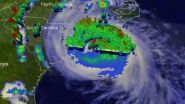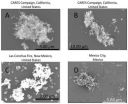(Press-News.org) VIDEO:
On July 3, NASA's TRMM satellite passed over Arthur and saw intense bands of thunderstorms north of Arthur's well defined eye dropping rainfall at a rate of over 98.4 mm...
Click here for more information.
Hurricane Arthur made landfall in North Carolina on July 3, and today, July 4, it is bringing its own fireworks along the Mid-Atlantic and New England states. Those fireworks were in the form of "hot towers," powerful, high thunderstorms with heavy rainfall that indicate strengthening. NASA's TRMM satellite spotted those fireworks before Arthur made landfall.
Hurricane Arthur made landfall on July 3 at (11:15 p.m. EDT) over the Shackleford Banks between Cape Lookout and Beaufort, North Carolina.
The Tropical Rainfall Measuring Mission or TRMM satellite, managed by both NASA and the Japan Aerospace Exploration Agency flew directly over Arthur on July 3, 2014 at 19:22 UTC (3:22 p.m. EDT) as the hurricane was becoming increasingly more powerful. At NASA's Goddard Space Flight Center in Greenbelt, Maryland an analysis of rainfall from TRMM's Microwave Imager (TMI) and Precipitation Radar (PR) instruments was overlaid on a combination visible/Infrared image taken from NOAA's GOES-East satellite. The combined image showed that intense bands of thunderstorms north of Arthur's well-defined eye were generating rainfall at a rate of over 98.4mm (3.9 inches) per hour.
One of the TRMM Precipitation Radar's most useful functions has been it's ability to provide 3-D vertical profiles of precipitation from the surface up to a height of about 20 km (12 miles). TRMM PR data were used to create a 3-D view of hurricane Arthur and showed tall thunderstorm towers near the center of the hurricane. These "hot towers" found reaching heights of over 15.0 km (about 9.3 miles) are often a sign that a hurricane is becoming more powerful. Even taller thunderstorm tops were found reaching heights of 16km (about 9.9 miles) in the states of North and South Carolina.
A "hot tower" is a tall cumulonimbus cloud that reaches at least to the top of the troposphere, the lowest layer of the atmosphere. It extends approximately nine miles (14.5 km) high in the tropics. These towers are called "hot" because they rise to such altitude due to the large amount of latent heat. Water vapor releases this latent heat as it condenses into liquid. NASA research shows that a tropical cyclone with a hot tower in its eyewall was twice as likely to intensify within six or more hours, than a cyclone that lacked a hot tower.
On July 4 at 7:00 a.m. EDT, Arthur was a category 2 hurricane with maximum sustained winds near 100 mph. A category 2 hurricane on the Saffir-Simpson hurricane scale has sustained winds between 96-110 mph. Satellite imagery showed that Arthur still maintained an eye, and that eye was centered near 36.5 north latitude and 74.7 west longitude. Arthur was moving to the northeast at a speedy 23 mph (37 kph) and is expected to speed up in the next couple of days. Arthur is expected to become a post-tropical cyclone tonight or Saturday, according to the National Hurricane Center (NHC).
The NHC forecast called for Arthur's center to move well offshore of the Mid-Atlantic coast of the U.S. today, pass southeast of New England tonight, and be near or over western Nova Scotia early on Saturday, July 5.
As a result of the forecast track, many warnings and watches are in effect from the Mid-Atlantic to Canada. A hurricane warning is in effect for Ocracoke Inlet, North Carolina to the North Carolina/Virginia border, and the eastern Albemarle Sound. A tropical storm warning is in effect for the North Carolina/Virginia Border to Cape Charles Light, Virginia including the mouth of the Chesapeake Bay, the western Albemarle Sound, Nantucket and Cape Cod, Massachusetts from Provincetown to Woods Hole.
Arthur is expected to pick up speed and zip up to the Canadian Maritimes late today, July 4, so tropical storm watches extend that far north. A tropical storm watch is in effect for New Brunswick from U.S./Canada border to Grand-Anse. It includes all of Nova Scotia Including Cape Breton Island, and all of Prince Edward Island.
INFORMATION:
For storm surge, wind and rainfall effects, visit the NHC website at; http://www.nhc.noaa.gov.
Text credit: Rob Gutro/Hal Pierce
NASA's Goddard Space Flight Center
NASA sees Hurricane Arthur's July fourth fireworks on US East Coast
2014-07-07
ELSE PRESS RELEASES FROM THIS DATE:
Conclusion of the Lindau Nobel Laureate meeting
2014-07-07
The 64th Lindau Nobel Laureate Meeting ended with a panel discussion entitled "Science for the benefit of mankind" on Mainau Island, Lake Constance, Germany, today." 37 Nobel laureates and more than 600 selected young scientists from 80 countries had participated in the week-long meeting in the Bavarian city of Lindau since last Sunday. A boat trip to Mainau at the invitation of the State of Baden-Württemberg marked the finish of the programme which was devoted to medicine and physiology. In 1895 Alfred Nobel determined in his will that the Nobel Prizes shall be awarded ...
New optogenetic tool for controlling neuronal signalling by blue light
2014-07-07
Institute for Basic Science (IBS), the main organization of the International Science and Business Belt project in South Korea, has announced that a group of researchers, led by professor Won Do Heo, have developed a new technology in the field of optogenetics that can remotely control specific receptors by light. They have named this new technology "OptoTrk" and it has succeeded with neuronal differentiation inducement.
The most significant feature of OptoTrk technology is that it requires only light to activate neuronal functions without the need of other substances. ...
Perspective of the PandaX dark matter experiment
2014-07-07
The PandaX experiment of China, which is located in the deepest underground laboratory, has released its technical design report recently. The full article will appear in SCIENCE CHINA Physics, Mechanics & Astronomy, 2014, 57(8): 1476-1494.
The Particle and Astrophysical Xenon (PandaX) collaboration was established in 2009 and mainly supported by the Ministry of Science and Technology, the Ministry of Education in China, the Natural Science Foundation of China,and Shanghai Jiao Tong University. The experiment is suitable for both direct dark matter detection ...
New type of soot particle discovered from wildfire emissions
2014-07-07
RENO – Every year, wildfires clear millions of hectares of land and emit around 34-percent of global soot mass into the atmosphere. In certain regions, such as Southeast Asia and Russia, these fires can contribute as much as 63-percent of regional soot mass.
In a paper published in Nature Scientific Reports, a team of scientists led by Rajan Chakrabarty from Nevada's Desert Research Institute report the observation of a previously unrecognized form of soot particle, identified by the authors as "superaggregates," from wildfire emissions. These newly identified particles ...
Blocking cells' movement to stop the spread of cancer
2014-07-07
Insights into how cells move through the body could lead to innovative techniques to stop cancer cells from spreading and causing secondary tumours, according to new UCL research.
Scientists discovered that cells can change into an invasive, liquid-like state to readily navigate the narrow channels in our body. This transformation is triggered by chemical signals, which could be blocked in order to stop cancer cells from spreading.
Most cancer deaths are not due to primary tumours, but to secondary tumours in vital organs, such as the lungs or brain, caused by cells ...
Do you look infected? Should I kill you? No, I'm fine, move along
2014-07-07
Some viruses can hide in our bodies for decades. They make 'fake' human proteins that trick our immune cells into thinking 'everything is awesome', there's nothing to see here.
Now researchers at the Imaging Centre of Excellence at Monash and Melbourne Universities have determined the basic structure of one of the two known families of these deceptive proteins.
Using synchrotron light and working with a common virus that lives in people happily and for the most part harmlessly, they worked out the structure of the fake proteins. This is an important first step towards ...
NUS researchers discover novel protein complex with potential to combat gastric cancer
2014-07-07
A team of scientists from the Cancer Science Institute of Singapore (CSI Singapore) at the National University of Singapore (NUS) discovered that a protein named IL23A is part of our stomach's defence against bacterial infection which leads to gastric cancer. This finding could potentially be used to combat the deadly disease.
The research group, led by Professor Yoshiaki Ito, Senior Principal Investigator at CSI Singapore, also showed that the production of IL23A by stomach cells requires the tumour suppressor gene, RUNX3, which is frequently silenced in gastric cancer. ...
Water bonus flows from climate change measures
2014-07-07
The equivalent of one-third of Melbourne's water use could be saved each year through the implementation of efficiency measures that deal with climate change, according to a new study.
Researchers at the Monash Sustainability Institute analysed the water-saving potential of 74 options for reducing greenhouse gas emissions identified in ClimateWorks Australia's award-winning Low Carbon Growth Plan for Australia. The research was published this week in Springer's international journal Climatic Change.
Monash University Research Fellow Dr Philip Wallis said an analysis ...
First cancer immunotherapy for dogs developed
2014-07-07
As in humans, cancers in dogs have complex causes. The interaction of the environment, food, and genetic disposition are the most well known factors. Today nearly all methods of human medicine are basically available for dogs with cancer, but this was not true of cancer immunotherapy so far.
So-called cancer immunotherapy - which is the treatment of tumors by the use of antibodies - has been established and used very successfully in human medicine for about 20 years. Since cancer cells bear very specific antigens on the surface, the corresponding antibodies bind to these ...
Novel type of bird pollination mechanism discovered in South America
2014-07-07
The genus Axinaea belongs to the large, mainly tropical flowering plant family Melastomataceae (Meadow Beauty Family). Most of the ca. 5000 species in the family rely on bees for their pollination. Only about 100 are known to be pollinated by other insects or vertebrates. The flowers of Axinaea appear in clusters of few to more than twenty flowers and the petals of the different species are pink, yellow, orange or red. The stamens (male reproductive organs) stand out based on the contrasting colours of their bulbous appendages. The pollination mechanism of Axinaea had never ...







